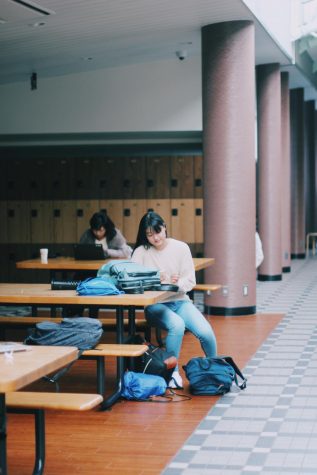Photo by Marina Ten Have, Dohyun Kim
Students from grades 9 to 12 take a moment to chat or study in the library during the month of December, one of the busiest times of year for the popular location.
The Great Book Locker Room – Library Schism
“So.. are you book locker room or library?” I’m quite sure that all of us know exactly what this means. Yes, I am talking about the unspoken divide between two distinct groups of students here at ASIJ—a schism so prevalent, that it was the only thing that was consistently mentioned through all of my interviews; so naturally, I wanted to find out more. I wanted to unpack the underlying factors that have led us to a rigid sectionalism within our community, and why this matters for us both as individuals and as a school.

Let us first try to understand the “Great Book Locker / Library Schism.” A few interviewees suggested that it is a spatial issue: a literal, physical, architectural problem. Notice how despite our cold winters, the school incorporates a significant amount of outside space. The only indoor area meant specifically for hanging out is the book locker room, yet it certainly does not provide nearly enough space for 500 students. So where do the others go? Well, the library!
Already, there is an inevitable, physical divide that is established. On top of this, a few interviewees found that since ASIJ has an elementary, middle, and high school, many social groups developed throughout the course of many years. Thus many of us get too comfortable in our own social circles and don’t feel that need to reach out, making it very hard for newcomers. One student who came from an American public school said that it took him up to a year to find a “solid friend group” because the cliques were so established.
So, how does this sectionalism shape, or promote certain features of our environment?
“Diversity” is a word that was brought up almost immediately. Senior Tyler Cross put it quite perfectly: “ASIJ is diverse—but it’s a limited diversity.” What does this mean? Cross defines the diversity here at ASIJ as one that is inherently part of our school. Having a mixed-race majority—though it may be predominantly Eurasian—makes us automatically more diverse than most Japanese or American public schools. However, we are limited because of the demographic filtration that occurs even before students are admitted into the school, namely in the form of economic discrimination—a factor that often filters the scope even further.

This is something we, as students, cannot entirely control. But paired with the further divisions we have created within our community, there is even less space to open ourselves up to ideas and perspectives. Many people feel that our school culture has been shaped by quite a limiting standard—based on an exclusive hybrid of Japanese-American elements— through the way we dress, the music we listen to, and even the use of certain bilingual words. Although this does create an interesting, and in some ways inherently ‘diverse’ culture, some students feel left out and excluded.
So, how does this relate to the social divide at our school? Well, it all really goes back to the lack of social interaction. Since we are so stuck with our own people, there are limited opportunities for us to mold our culture in new ways, new directions. There is little chance to explore further and connect with those who hold unique tastes in music or fashion.

Why is this a concern? Well, consider this: at least one student at our school is scared to listen to the music she likes in fear of being judged by her peers. Another student is scared of expressing his support for the Republican party for the same reason. They are scared to express themselves in fear of deviating from this ASIJ cultural norm that we have created or at least allowed to persist.
So, yes, we are the American School In Japan, but we represent something more: We are ambassadors of multiculturalism and broken barriers. It’s time that we started to work towards cultivating a more fluid, interactive and expressive community, not only to improve our school, but to prepare ourselves for the diversity that lies beyond.
